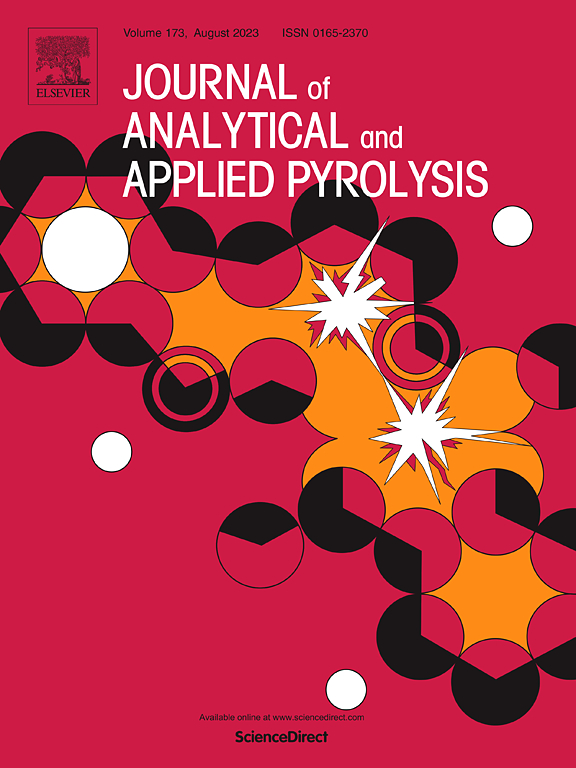Influence of pyrolysis temperature on crude palm pyrolysis oil from fresh palm fruit bunches in a double-inclined screw reactor
IF 5.8
2区 化学
Q1 CHEMISTRY, ANALYTICAL
引用次数: 0
Abstract
Thailand, one of the world’s largest crude palm oil producers, faces increasing energy demands and dependence on fossil fuel imports. This study presents a novel application of a double-inclined screw reactor for the slow pyrolysis of fresh palm fruit bunches (FFB). The effects of temperature variation (400°C, 500°C, and 600°C) on product yields and pyrolysis oil properties were systematically analyzed. The results showed that higher temperatures increased pyrolysis gas production (27.3 % at 400°C to 31.95 % at 600°C) while reducing pyrolysis oil yield (25.2 % to 16.4 %) due to enhanced thermal cracking. Biochar yield slightly declined, whereas wood vinegar increased from 37.8 % to 42.5 %, indicating greater decomposition of cellulose and hemicellulose. The physicochemical analysis of pyrolysis oil revealed a lower heating value ranging from 38.2 to 39.2 MJ/kg. While 400°C provided the highest oil yield, it contained a higher proportion of oxygenated compounds, reducing stability. 500°C was identified as the optimal pyrolysis temperature, offering a balance between oil yield (21.9 %) and quality, with lower oxygen content, improved stability, and better combustion properties. These findings highlight the potential of FFB-derived crude pyrolysis oil as a promising alternative fuel. Furthermore, the use of a double-inclined screw reactor proved effective for producing high-quality bio-oil from palm-based biomass, offering a novel approach to sustainable energy production for continuous industrial applications.
双斜螺旋反应器中热解温度对鲜棕榈果束粗棕榈热解油的影响
泰国是世界上最大的棕榈油生产国之一,面临着日益增长的能源需求和对化石燃料进口的依赖。本研究提出了一种新的双倾斜螺旋反应器在新鲜棕榈果束(FFB)缓慢热解中的应用。系统分析了温度变化(400°C、500°C和600°C)对产物收率和热解油性质的影响。结果表明,温度升高使热解产气量增加(400℃时为27.3 %,600℃时为31.95 %),热解产油率降低(25.2 %,600℃时为16.4 %)。生物炭产率略有下降,而木醋产率则从37.8% %提高到42.5 %,说明纤维素和半纤维素的分解更大。热解油的理化分析表明,热解油的热值较低,在38.2 ~ 39.2 MJ/kg之间。虽然400°C的产油率最高,但含氧化合物的比例较高,降低了稳定性。500°C为最佳热解温度,在产油率(21.9 %)和质量之间取得平衡,氧含量更低,稳定性更好,燃烧性能更好。这些发现突出了ffb衍生的粗热解油作为一种有前途的替代燃料的潜力。此外,使用双倾斜螺旋反应器从棕榈基生物质中生产高质量生物油被证明是有效的,为持续工业应用的可持续能源生产提供了一种新的方法。
本文章由计算机程序翻译,如有差异,请以英文原文为准。
求助全文
约1分钟内获得全文
求助全文
来源期刊
CiteScore
9.10
自引率
11.70%
发文量
340
审稿时长
44 days
期刊介绍:
The Journal of Analytical and Applied Pyrolysis (JAAP) is devoted to the publication of papers dealing with innovative applications of pyrolysis processes, the characterization of products related to pyrolysis reactions, and investigations of reaction mechanism. To be considered by JAAP, a manuscript should present significant progress in these topics. The novelty must be satisfactorily argued in the cover letter. A manuscript with a cover letter to the editor not addressing the novelty is likely to be rejected without review.

 求助内容:
求助内容: 应助结果提醒方式:
应助结果提醒方式:


